World-Famous or Legendary Muskie “Hotspots” – Part VIII
Category: article
Apr 7th, 2021 by Keith Worrall
Modified Apr 14th, 2021 at 10:50 AM
World-Famous or Legendary Muskie “Hotspots” – Part VIII
by Larry Ramsell, Muskellunge Historian
Let us now return to the Turtle-Flambeau Flowage in Wisconsin, and cover “Hotspot” number three there. I’ll again note that the two largest verified muskies caught from this log-laden Pond, both over 50-pounds, were caught by women! This second one will likely make us anglers wonder again if we are doing the right things.
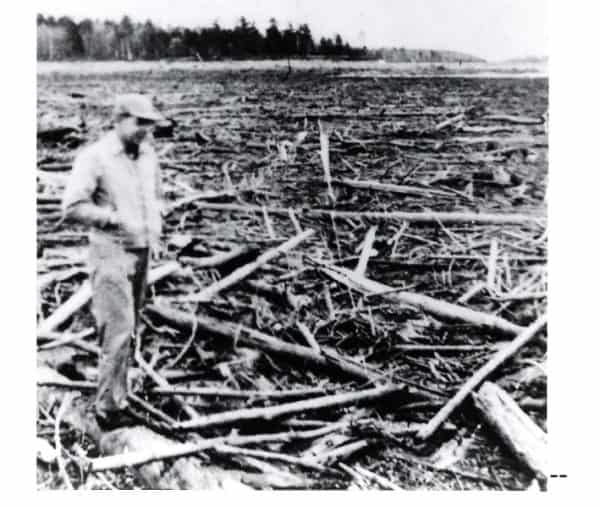
Just add water! TFF pic taken at low water level. Courtesy Bill Tutt.
Dollar Island is a relatively small island in the big basin on the Flambeau side of the Turtle-Flambeau Flowage near the old river channel.
Dollar Island
Mrs. Everett Reinardy – 50-pounds 1-ounce – 1962
I first learned about Vi Reinardy’s muskie from R.P. White in a letter he wrote me about the Rita Hillenbrand 52 ½-pounder from the Flambeau Flowage, Wisconsin, where Mrs. Reinardy also caught hers on October 27, 1962. Mr. White was able to secure a photograph of the Reinardy muskie for which I am most grateful.
Mr. White related that the fish was “53 ½ inches”…”The”… “fish was caught off an island shore, some sand and rock, fairly quick drop off to 20’ with a 35’ hole 100’ away and a rocky island about the same distance from the island”…In March of 2007, I received an email from Reg Delwiche with some new information and another great photograph that better showed the tremendous girth of the Reinardy fish.
Reg’s parents Paul and Gerry Delwiche were fishing with the Reinardy’s on that fateful day. They …”were eating shore lunch and listening to the Ohio State-Wisconsin football game.” …”Football was a big deal to them… so that is why the game captured their interest”…”During the game, Wisconsin was about to score a touchdown. Someone looked back at the boats
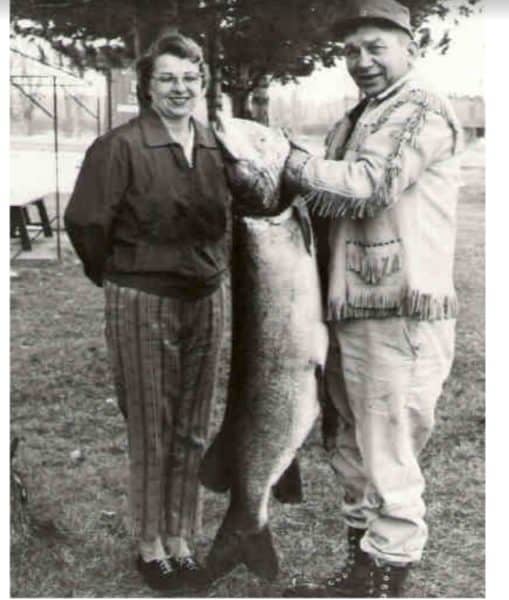
Vi Reinardy with guide Laurel Heinski. Courtesy R.P. White.
where they left the suckers out”…”and a bobber was missing. Ev told Vi to go down and check. She went down to the boat and the bobber was down, so she started reeling it in. Everyone else was back by the radio until she hollered that she had a fish on. Little did they know what she had!”
Needless to say, the huge muskie was landed and history made. Mrs. Reinardy’s muskie was the largest Wisconsin muskie landed by a woman at the time. The mount of her fish is at the NFWFHF in Hayward, Wisconsin, donated by Everett Reinardy
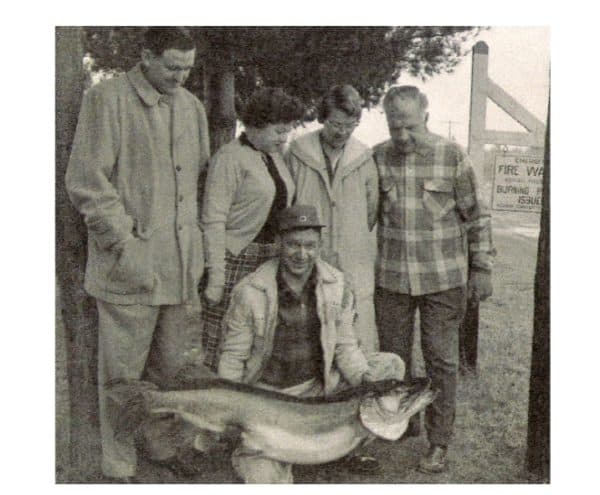
She had THIS! Photo courtesy Reg Delwiche
After Mrs. Reinardy’s death, I received information on certification of the fish’s weight from another noted area guide, Dick Sleight. I had discussed this fish with him at the Milwaukee Sports Show and he later sent me the data, including an affidavit of two weight witnesses, Harry Kaczmarek, Sr. and Ed Redick, and a copy of the certification from Mercer Hardware Co., Mercer, Wisconsin. The official weight was 50-pounds 1-ounce and the giant muskie was 53-inches long with a huge 29-inch girth! Ed Alvy, Hilby Schutt, Vera Brandt, Bernard Bos and W.A. Carrow, all of Mercer, Wisconsin, witnessed this.
Thanks to all the folks who took the time and effort to contribute to putting all the pieces of this interesting “muskie puzzle” together! I am humbly grateful.
Lake Chautauqua cont.
We now return to Lake Chautauqua, New York. In Part IV we went back in history for our information, but now we come forward to the present. I reached out to Guide and Lure Maker Mike Sperry and the following was what he had to say:
“Chautauqua lake ‘The Musky Capital of The World’. The signs were still up in places around the lake with that moniker in the mid to late 70’s (while in Wisconsin, Boulder Junction and Hayward, went to court in a battle over the use of that title giving no consideration to Lake Chautauqua).
With the nation’s first musky hatchery and an annual stocking program, Chautauqua is still one the of the top musky lakes in the country. Natural reproduction does take place but the lake relies on the great stocking program. The NYS DEC run hatchery raises and stocks 13,000 8” to 9” fingerlings every Fall. Known for its numbers and nice average sized fish, Chautauqua is a fertile lake with vast weed beds and a weed line that rims the entire shoreline. It’s great spawning habitat for the primary forage of Yellow Perch. There are a handful of rock bars and gravel areas that hold fish along with the weed lines. Yellow Perch are abundant but there is a big population of White Perch, Sunfish and Bullhead as well. Chautauqua is also known for its great Walleye and Bass fishing. Several Musky tournaments are held on Chautauqua each year and in October of 2004, it was host to the PMTT (Professional Muskie Tournament Trail) Championship. Many Bass tournaments and a few walleye tournaments are held each year as well.
“Chautauqua gets a ton of boat traffic during the summer months consisting of both fisherman and pleasure boaters. There was a big up tic in boating traffic in 2020. As a full-time fishing guide and having fished the lake since the mid 70’s, I don’t recall as much boating and fishing pressure as in 2020 (due I suspect to the COVID-19 virus). I would expect similar pressure this season. The increase in boating and fishing activity is great for the local economy but can change the fishing tactics to be successful. Fishing earlier in the morning and later in the evening to avoid the traffic helped put fish in the net. (My) Preferring to cast over trollIng allows anglers to get into areas missed by trollers. There are several community hot spots that hold muskies and I have a run planned each day, but in 2020 we found some new hot spots off the beaten path.
With great habitat, forage base, and a well-managed stocking program, the future looks bright for Chautauqua Lake Musky fisherman.”
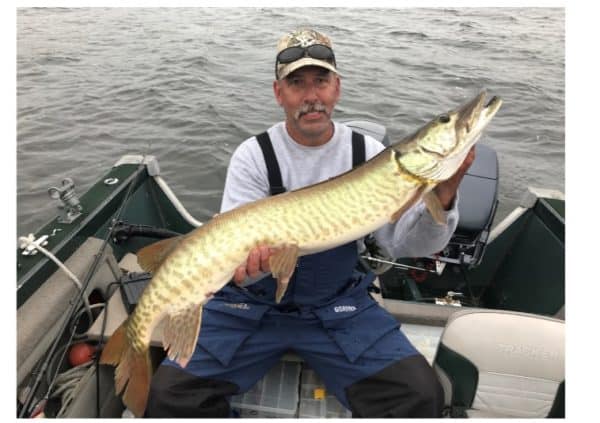
Guide Mike Sperry and a typical Lake Chautauqua Muskie.
Mike Sperry is a NYSDEC Licensed Guide who has been fishing the waters of Chautauqua Lake for over 40 years. Mike offers guided fishing trips for muskellunge, walleye, bass and panfish. His specialty is casting for muskies. Mike is the founder and past president of the Chautauqua Lake Musky Hunters from 2002-2007. Mike has also fished with Pete Maina during the filming of the television show called The Next Bite while filming the episode entitled Chautauqua Muskies Unleashed.
He was born and raised in the Lakewood, NY area and has fished Chautauqua Lake since the mid 1970’s. As a child, he lived very close to the lake, therefore, it has always been a big part of his life. At the age of 9, he caught his very first musky and was hooked on fishing for the elusive lunge ever since!
He is determined to work hard to make your day on the water enjoyable and memorable, regardless of what we are fishing for – musky, walleye, bass or panfish.
When he is not on the water fishing, you can find him back in the shop working on his own lure collection known as “Smiling Jack Lures”. All his lures are custom, handmade, and tested right on Chautauqua Lake. They have been proven successful time and time again.
Mike can be contacted at: Chautauqua Reel Outdoors Guide & Tackle, PO Box 41, Ashville, New York 14710
Phone (716) 763-2947
https://www.chautauquareeloutdoors.com/
Lac Vieux desert, Wisconsin/Michigan
Bill Hamblin mentioned this “iconic” fertile body of water in Part VII, and due to its history of producing “World Class”, not to mention “World Record” caliber Tiger “hybrid” Muskies, I felt it must be included in this Series.

“Katikitigon”, aka “Gete-gitigaanizaaga’igan”
This mostly shallow 4017-acre lake, Lac Vieux desert, lies astraddle of the Michigan/Wisconsin borderline, and therefore any lake credit accrues to both states unless the definite location of a particular catch is known.
From the late Peter Haupt: “’Katikitigon’ was the (simplified) name the Ojibwe people used for the water that Frenchmen called Lac Vieux desert (translated from French to “Gete-gitigaanizaaga’igan” meaning “Lake of the Old Clearing”, or Old Garden” – Wikipedia). The natives resided on the northeast shore and thrived on wild rice and other lake related bounty. French traders made a settlement on one of the islands. The logging industry used its strong influence to put a dam across the outlet, the source of the Wisconsin River, and impounded the lake about three feet. They needed a head of water to flush pine logs downriver to mills at Eagle River and Rhinelander. Resorts began to spring up along the south and west shores. A fisherman could board a train at Chicago or Milwaukee and ride all the way to Stateline (now called Land O’ Lakes) or get off at Conover’s Stop and take the logging spur to Hackley (now Phelps).”
The lake’s muskie history is long and first made itself well known in 1919, when Indian Guide John Knobla boated a giant “muskie” that weighed 51-pounds and 3-ounces. At the time, it was accredited World Record status as a muskellunge, as hybrid muskies were then unknown. It held record status for 10 years atop the Field & Stream fishing contest listing. Over the past 100 years, Lac Vieux desert has produced untold numbers of trophy sized Tiger Muskies!
Let us at this point review the establishment of world record status for the hybrid. In June of 1975, I, as World Records Secretary of the NFWFHF, put out the following news release:
Through the efforts of the hybrid committee of the Muskellunge Club of Wisconsin, absolute verification has been obtained for a 50-pound 4-ounce muskellunge hybrid (Esox masquinongy x Esox lucius), 56-inches long, with a girth of 26-inches, that was caught June 28, 1951, by Dolores Ott-Lapp of Land O Lakes, Wisconsin, from Lac Vieux Desert, Wisconsin.
Due also to the efforts of the hybrid committee, the Department of Natural Resources of the State of Wisconsin, is establishing a separate category for muskellunge hybrids, and will undoubtedly recognize Mrs. Lapp’s fish as the Wisconsin state record.
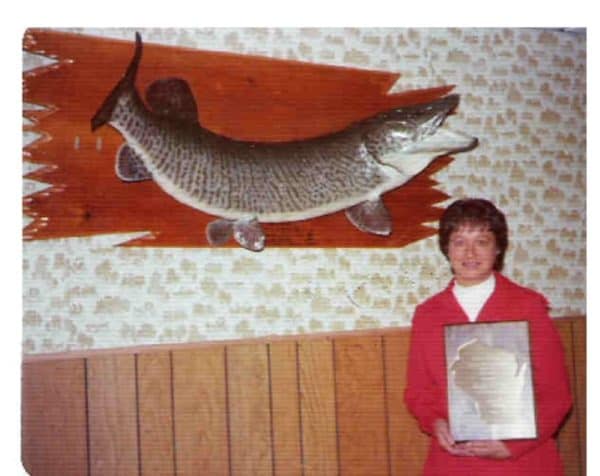
Dolores Ott-Lapp & plaque from Muskellunge Club of Wisconsin.
Author photo.
In keeping with the goals of the National Fresh Water Fishing Hall of Fame, new world record categories have been established for the muskellunge hybrid. In addition, because of the absolute verification of the hybrid caught by Dolores Ott-Lapp, it is now officially recognized as the All-Tackle World Record Hybrid Muskie.
This magnificent specimen of the “tiger” muskellunge created quite a furor when caught. One of the photos of Mrs. Ott-Lapp and her fish went on to become the most reproduced “muskellunge” photograph in angling magazines and newspapers throughout North America and Europe and it still gets published periodically today (including here). Literally thousands of picture post cards were mailed showing her fish.
Mrs. Ott-Lapp’s hybrid was installed as the world record hybrid by the NFWFHF in 1975 and it remained in the top spot until 1978 when photo evidence proved that the Knobla 1919 world record, 15-ounces heavier than Ott-Lapp’s fish, was a hybrid rather than a true muskie. Mrs. Ott-Lapp’s fish is now the NFWFHF unlimited line-class hybrid muskellunge record in the conventional angling division, even though she said she had caught the fish on 40-pound test line. IGFA also recognizes this fish. In addition, Delores’ fish at the time was the largest “muskie” ever caught by a woman in the State of Wisconsin and is still the 2nd largest, Rita Hillenbrand’s being number 1.
Following is the story of Delores’ catch as excerpted from an unidentified magazine article I received from the late Peter Haupt in 1989. It was titled A Record Memory by Jeff Ayers.
“I had my hair in curlers, getting ready to go to work when my husband, Jack, said ‘C’mon let’s go pitch for a while.’ I said OK, but I don’t have much time. We jumped in that boat (points to picture) and went in front of that white boat house over there.” She walked to the window and pointed to a large white boathouse ¼ mile away on Lac Vieux Desert’s south shore. “It used to be called Duke’s resort, but it’s a private home now.”
“…We hadn’t been fishing long when he hit on a red and white bucktail. It just stopped the bait dead. For an instant I didn’t think it was a fish, just a log, but Jack shouted, ‘Set the hook,” and I hit him hard. We knew right away it was a monster. I screamed to Jack ‘Take this rod,’ he said, “No you keep that line tight, play him out he’s huge.’”
“He jumped and we saw just how big he was. My God, how that fish fought. He broke water three times all together. I guess the fight lasted about 45 minutes. Finally, I got him up to the boat and Jack shot him in the top of the head. It didn’t even phase him. I fought him some more and then Jack shot him through the side of the head and killed him. Jack grabbed the fish by the gill covers and hauled him in over the side. I was exhausted.
“We went right over to Bill Schwartz’s resort (now Sunrise Lodge; Peter Haupt 1989) to weigh the fish. Unofficially he weighed 52 lbs., at that time there was no differentiation between a Tiger Musky and the Silver Musky. Louis Spray had the world record Silver over at Hayward. We knew we didn’t have the record but nobody had seen a Tiger that big.
We took him to the Gateway Hotel to show him to some people Jack was guiding. After a while we weighed him officially in town (at Neiman’s grocery – on a meat scale; Peter Haupt 1989). 50 lb., 4 oz. Fifty-six inches long with a 26” girth…”
Dolores then said to the writer and he wrote …“Look here,” she points to a hole in the tail of the fish. “Someone else must have had this fish on and tried to shoot him.” The hole has been covered on the mounted trophy but you can see where it was. The fish had a bigger girth than me back then,” she related with a delightful laugh. The monster Tiger won Dolores an outboard motor from the Headwaters Fishing Contest but placed only third the Field and Stream Contest. Edged out by mere ounces by two Silver Muskies…
Mrs. Ott-Lapp caught her hybrid on a Marathon Musky Houn, as reported in Field & Stream magazine, while using a “…steel Heddon rod and a Pflueger Supreme reel. I had 40-pound test line…my husband Jack shot it. Nearly everyone shot their muskies back in those days…” as she was quoted as saying in the Musky Notes newsletter in 1995.
Immediately after the catch, the Ott-Lapp hybrid weighed 52-pounds on an unofficial scale (there is no record of any effort to certify the unofficial scale) and later, on an official scale, after the big hybrid had hung in the sun and wind for some time, a weight of 50-pounds 4-ounces was recorded and reported to Field & Stream. Could the Dolores Lapp-Ott hybrid have beaten the weight of Knobla’s muskie if the weigh-in was handled differently? We’ll never know!
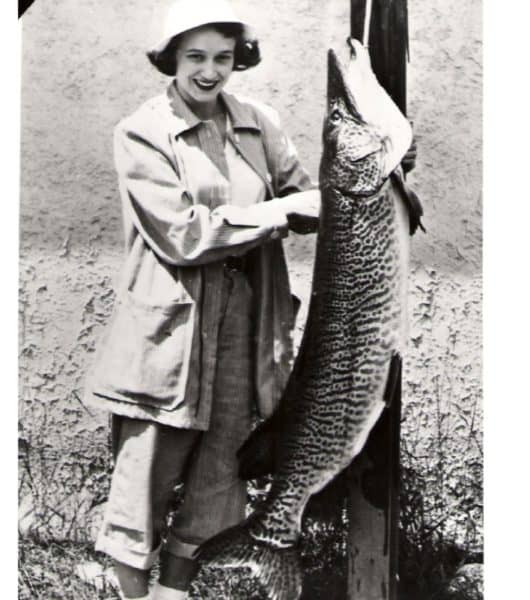
Delores and her Giant “Tiger”. Courtesy J. Peter Haupt and Doug Lenicheck, Muskellunge Club of Wisconsin. World’s most published “Muskie” photograph!
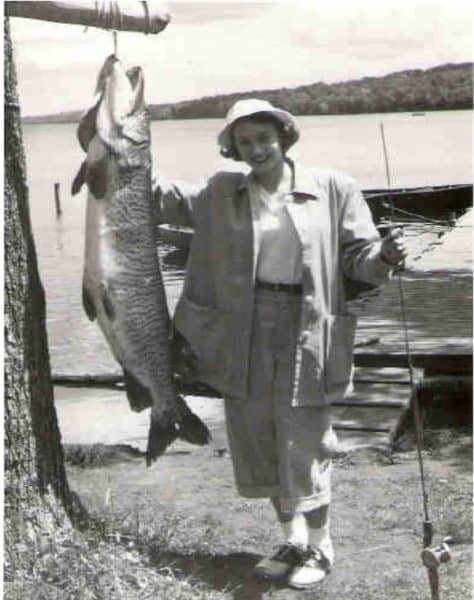
Dolores, her rod & reel-courtesy J. Peter Haupt & Doug Lenicheck.
Note the bullet hole in the tail! Gotta love the Saddle shoes!
At the time, the Lapp hybrid was being investigated, another fish was also checked out. That fish was a 51-pound 3-ounce musky, also caught from Lac Vieux Desert in 1919, by John A. Knobla. Although that fish was the world record muskellunge from 1919 to 1929, the Hybrid Committee had reason to believe that it may have, in fact, been a hybrid, as the mounted fish reported to be the 1919 fish was repainted by expert taxidermist Fred Aman of Conover. Wisconsin, who verified that the mount was indeed a hybrid (Mr. Aman handled over a hundred hybrids). Although the weight and date on the plaque of this mounted fish corresponded with the 1919 world record, the angler’s name was omitted, preventing a conclusive tie in. More importantly, there were no available pictures of the 1919 fish at the time, therefore precluding absolute verification.
From 1975, the Hall continued the investigation of the 1919 fish and subsequently verified that it was, in fact, a hybrid. After extensive perusal of the archives, the final tie-in was made when an exceptionally good photograph of the angler and his fish was found in the November, 1920 issue of Outdoor Life magazine. Since the world record musky of 51-pounds 3-ounces caught by John A. Knobla on July 16,1919, was in fact a hybrid, it therefore assumed the position of All Tackle World Record Muskellunge Hybrid. The Story:
When Wednesday, July 16, 1919, dawned, the muskie world was only a few hours away from crowning a new king! It was on this day that John A. Knobla caught a 51-pound 3-ounce, 52 ¼-inch (incorrectly reported in previous “Compendia” as 54-
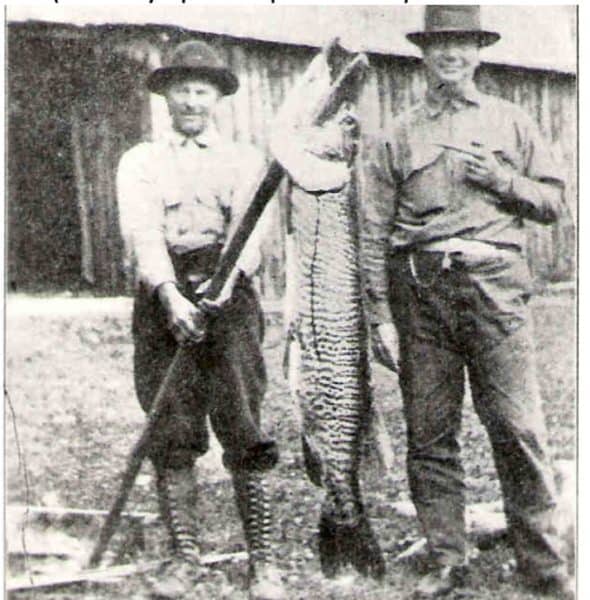
1920 Outdoor Life photo found in the archives by Rod Ramsell.
John Knobla is on the left.
inches based on an “estimate” by Peter Haupt – this new length measurement, from the plaque on the original mount, was likely “fork length” as that was the required measurement for the Field & Stream contest for many years and would equate to an approximate 55-inch total length) muskie with a 25¼-inch girth out of Lac Vieux Desert, Wisconsin/Michigan that eclipsed the previous world record muskie by just 3-ounces!
Mr. Knobla was a well-known and highly respected guide fishing out of the Thomas Resort (now Sunrise) on Lac Vieux Desert. Several early magazine articles extolled his virtues:
A Prize Musky of Lac Vieux Desert by Fred Bradford Ellsworth talked about him in the September 1915 issue of Field & Stream, A Bass Bug Fly Angler Asks About Muskies by Mr. Ellsworth in the June 1918 issue of Outdoor Life and Tigers of The Fresh Waters by Mr. Ellsworth in the November 1920 issue of Outdoor Life were articles that are known, the latter, talked about his record catch. Mr. Knobla’s fish was the Field & Stream contest winner in 1919 and was listed as the world record muskie until August 25th,1929. His record was also discussed in Tale of Record Fish by Seth Briggs in the May 1930 and April 1933 issues of Field & Stream.
For John Knobla, this fish was a well-deserved trophy, as he had been an area guide for many years and probably was one of the best and most well known in the state of Wisconsin. He was a friendly person and very talkative. In fact, the well-known outdoor writer of the times for Outdoor Life magazine, Fred Bradford Ellsworth, frequently wrote about Knobla as noted above and always with the utmost praise.
In his article, Tigers of the Fresh Waters in the November 1920 issue of Outdoor Life magazine, where the photo was found, Mr. Ellsworth had the following to say about Knobla’s fish:
…”Last year my old guide, John Kanobla (sic), took a 51-pounder…at Lac Vieux Desert.” (the articles picture caption was correct; 51-lb. 3-oz)…
In the 1960 issue of Field & Stream magazine it was also mentioned as follows:
.”.In 1919 the record was edged up 3-ounces by a Lac Vieux Desert, Wisconsin, catch”…
An interesting abstract to John Knobla’s world record is that in many stories written about his fish, it was described as a beautifully marked Wisconsin tiger muskie. This and stories I had heard in Eastern Wisconsin from various people indicated that Knobla’s muskie was possibly a hybrid muskie. It was in fact a hybrid “tiger” muskie (muskie-northern pike hybrid). This fact became obvious after a lengthy investigation culminating in 1979, when positive photographic proof in the form of a documented and authentic photograph was found by Rod Ramsell in Outdoor Life magazine archives, which conclusively illustrated that Knobla’s fish was indeed a hybrid. Knobla’s muskie is currently (in 2007) recognized as the World Record Hybrid Muskellunge by both the IGFA and the NFWFHF!
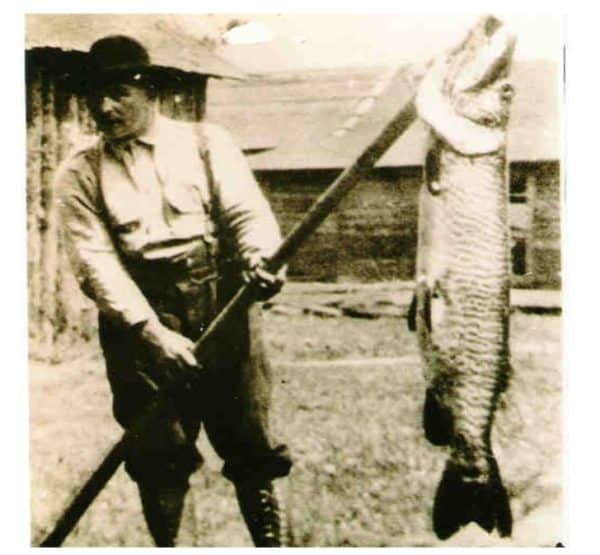
A new photo of Knobla’s Record “Tiger”
Photo courtesy Al Soczka
51-pounds 3-ounces, 52 ¼-inch (fl?)- length, 25 1/4 inch girth.
Caught July 16, 1919, Lac Vieux desert, Wisconsin/Michigan.
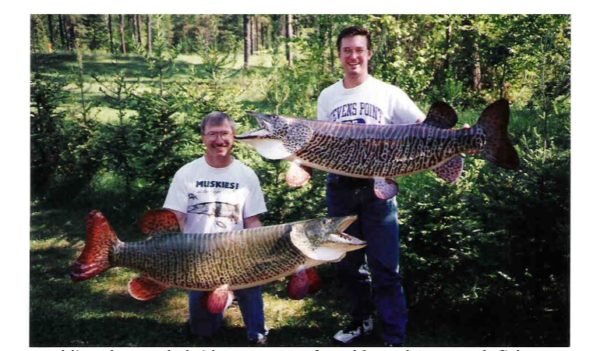
Holding the two hybrid re-mounts of Knobla and Ott-Lapp’s fish are Ron Lax (l) with the Ott-Lapp hybrid and Rick Lax (r) with the Knobla hybrid. Photo courtesy of Lax Taxidermy Conover, WI. Ron stated that he …”could see no difference in the size of these 2 magnificent Tigers”!
It was not realized until the late 1930’s that “well marked tiger muskies,” which occurred occasionally throughout muskie country, were actually a muskellunge and northern pike cross. Until that time, hybrids were believed to be, and promoted as well marked “true” muskies.
Even today, many anglers mistake the hybrid for the true muskie and probably will for years to come. Conversely, anglers often identify a well barred true muskie as a hybrid. As history and lack of knowledge of the times would have it, as well as a lack of photographic proof until Rod found the first photograph (another has since been found and a copy provided to me by Al Soczka), John A. Knobla’s 1919 world record was for many years noted as a muskellunge.
In addition to the world record change, the State of Wisconsin, when presented with the above information, also placed the Knobla fish in their record book as the state record hybrid. It is a wonderment that no larger hybrid has ever been caught and only the tiger shot and lost by “Musky Gus” (a “full bodied Tiger according to taxidermist Fred Aman, who viewed the decaying carcass”) from Lac Vieux Desert at 60-inches has been verified as having been larger than Knobla’s giant! IGFA also later created a record category for Tiger Muskellunge and listed Knobla’s fish.
DEFINITION OF TERMS FOR HYBRID MUSKELLUNGE
(Esox masquinongy x Esox Lucius)
by Rod Ramsell
CHEEK: The cheek is that part of the side of the head which is just behind and below the eye. It is part of the movable structure which makes up the side of the mouth and gill cover.
OPERCLE: The opercle is the true gill cover. It is that part of the side of the head which is behind the cheek and is usually marked off from it by a distinct groove.
BRANCHIOSTEGAL RAYS: The branchiostegal rays, more commonly called branchiostegals, strengthen and support the gill membranes below the cheek and opercles.
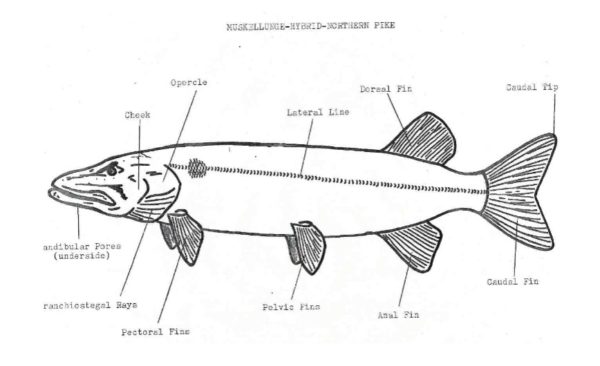
Anatomical Hybrid drawing by Rod Ramsell, Minnesota DNR
MANDIBULAR PORES: The mandibular pores are the pores on the underside of the lower jaws. Five or less per side is a northern pike. 6 or more per side is a muskellunge. Hybirds will be intermediate between the two.
TAXONOMIC DESCRIPTIONS OF MUSKELLUNGE,
NORTHERN PIKE and TIGER MUSKELLUNGE
Esox masquinongy (MUSKELLUNGE): Body long and oval with light bars on sides, fading to green or brown dorsally. Some — individuals may be all green or brown on sides with no bars. Cheeks and opercles scaled no more than 5/10 laterally. Mandibular pores usually 12 to 18. Branchiostegal rays usually 34 to 36 (total both sides). Tail tips pointed. End.
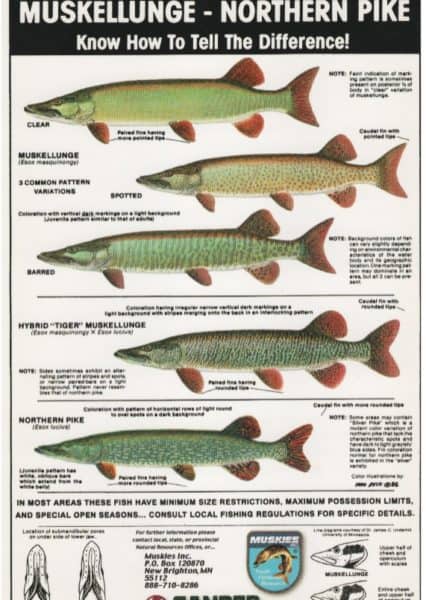
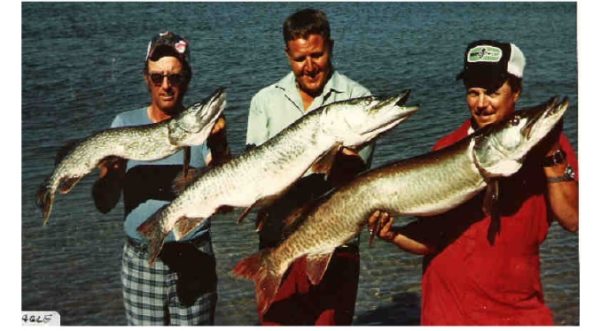
Mom (r), Dad (l) and the hybrid off-spring (c) & three great muskie anglers Doc Chan Cotton (l), Roger Halvorson (c) & Al Skaar
Dr. John Casselman, pre-eminent muskellunge (masquinongy in Canada), and pike researcher, formerly a research scientist for the Ontario Ministry of Natural Resources and currently of Queens University, shared the following:
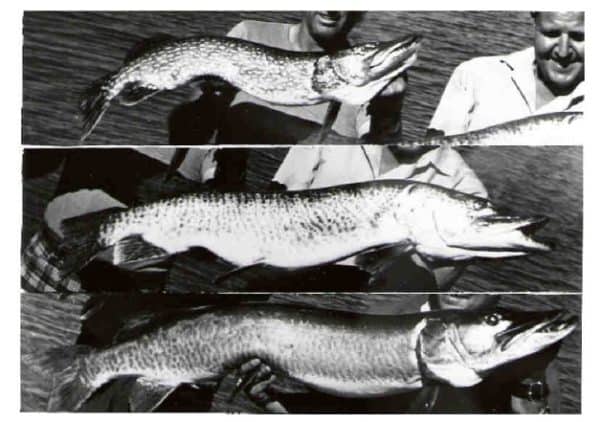
Pike (top) = light spots-dark background; Hybrid (center) = broken bars and spots on a light green or silver background; Muskie (bottom) = clear or dark spots and/or bars on a light or dark green background
“Hybrids are much shorter-lived. Partly, I think, because of their very rapid early growth. Species that do this seem to almost burn out. If you look at the 1986 paper in Managing Muskies that I published with the late Dr.Ed Crossman, (long considered the world’s leading Esocid research scientist) you’ll see the hybrid data… You could compare the hybrid with the muskellunge and you’ll see that the sample of hybrids was much younger. However, some hybrids reached a size that was quite large.”
His reference contained the following in the abstract:
“…Data are similarly described for 60 natural muskellunge-northern pike hybrids from 3 to 18 years of age, averaging 7.2 years and 6.8kg (13.67#) to 15.4kg (33.96#). Although the hybrids were slightly faster growing than were muskellunge up to approximately age 8, they did not appear to attain the maximum age or size of muskellunge…”
I am sure that there are many other Hotspots that I am not aware of even though I have fished muskies in 23 states and 2 provinces of Canada over the past 65 years. Any reader who knows of one or more Legendary or famous Hotspots, please let me know with a write-up of same and supporting photos if available and I will include them in a follow-up article(s).
Send it to me at: larryramsell@hotmail.com Thank you!